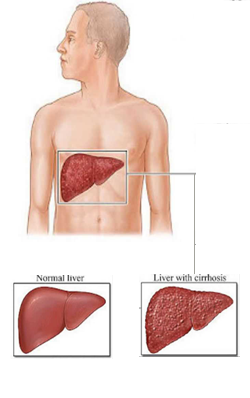
Cirrhosis is an advanced stage of liver disease in which most of the normal liver tissue has been replaced by fibrous tissue (scar tissue) and the resultant regenerative nodules (elevated lump like structures arising on the liver tissue due to failed attempt of body to repair the damage caused by the scar tissue). Both of these changes in the liver tissue lead to impairment of normal liver function.The most common underlying causes of cirrhosis include prolonged alcohol intake, infection by hepatitis B and hepatitis C viruses, fatty liver etc; apart from these underlying causes a large number of cases of cirrhosis occur without any apparent underlying cause.Cirrohosis is an irreversible condition; there is no cure for it. Hence symptomatic treatment is advised. Liver transplant is the only treatment option for advanced stages of the disease.
Symptoms
There are several presenting symptoms of cirrhosis, although in most of the cases during early stage of the disease there are hardly any symptoms. Symptoms become evident when there is significant destruction of the liver tissue.
The presenting symptoms of cirrhosis can be classified under following headings. These are
1. Symptoms due to impaired function of the liver tissue: these symptoms include
a) Jaundice characterized by yellow skin and mucous membrane (usually detected by yellowish discoloration of the white of the eyes)
b) Spider nevi: prominent vessels all over body. This lesion is characterized by one centrally located arteriole from which other smaller vessels are seen to radiate outwards.
c) Enlarged liver which can be felt on abdominal examination
d) Ascites: collection of fluid in the abdominal cavity
e) Gynecomastia: characterized enlargement of the male breasts
f) Hypogonadism: characterized by poor sexual drive, impotence, shrinkage of the testes (testicular atrophy)
g) Reddish discoloration of the palm
h) Bad breath
2. Symptoms due to portal hypertension: In this condition there is increased resistance to blood flow in the portal vein located in the liver tissue resulting into raised blood pressure in the portal system and various symptoms. common presenting symptoms of portal hypertension include
a) Enlarged spleen that can be felt on abdominal examination.
b) Esophageal varices: characterized by dilation of veins located in the lower third of the esophagus and their subsequent rupture and bleeding.
c) Caput medusa: characterized by presence of dilated spidery blood vessels on the abdominal wall.
3. Specific set of symptoms in advanced stage of the disease: these include
a) Increased bleeding and bruising tendency following minimal or no trauma.
b) Hepatic encephalopathy: As the liver fails to remove toxins, gets accumulated in the blood, and thereby these substances can reach the brain tissue and leads to several complications like impaired memory, mental clouding, confusion and ultimately coma and death.
Common complications of cirrhosis include
1) Repeated episodes of infections as the ability of the body to fight against infection is suppressed
2) Malnutrition: as along with loss of appetite (anorexia), cirrhosis makes digestion and absorption of several nutrients present in food.
3) Bone loss: bone loss or osteoporosis is a common complication associated with cirrhosis leading to increase episodes of fracture following minimal or no injury
4) Gallstone and infection in the gall bladder: as the bile flow is hampered due to cirrhosis (as gall bladder is located just beneath the liver) there are frequent attacks of infection in the gall bladder and gall stones
5) Increased chance of progression to liver cancer in the future
6) Sometimes multi organ failure may also occur.





